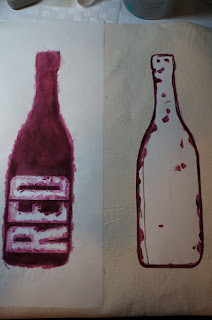I have been working the last few days on finishing up an assemblage piece to submit into a mixed media show. I am using a niche frame with shelf I found at the thrift store, a "visible man" I bought at the Paris Street Market in Littleton, the inside part of a typewriter and some wings.
Originally I was going to make the wings from metal trims that I had.
Even though I planned to paint them white, I thought it looked more like
he had a jet pack than wings. I will save them for another project.
I had bought this Apoxie Clay at a store called Collage in Portland while on vacation last year and finally tried it out. It has two parts like epoxy but has the consistency of polymer clay. I kneaded the two components together and used it to attach the typewriter part to the frame. The fame looks like it's wood on the face, but is totally infilled with styrofoam. It is very lightweight. I was worried that the typewriter part would be too heavy for it, but so far this Apoxie clay makes the connection seem totally solid. I also was able to use two nails to attach it, and drilled two holes that I threaded wire through from the backside to help as well. The clay can be painted while it is drying so I painted it black.

My visible dude got his legs chopped off with a dremel. He has a front and a back part so I used some blue tape to hold him together while I applied a layer of rice paper. I tore it into smallish pieces (1/2" x 1") and used fluid gel medium to attach it. I mainly did one coat of paper, but if the seams were still visible, I used another layer or two.

He then got a layer of paint to make him totally opaque. I used my printer to print images onto tissue paper. To print on the tissue paper, I used a glue stick to glue the leading edge of the tissue paper to regular copy paper. I did mangle some tissue paper in the process. I found if I glued it about a 1/2" from the edge of the copy paper, the printer had less problems grabbing it. Inkjet ink is not waterproof, so I took it outside and gave it a coat of spray-on matte sealer and let it dry. I scanned and printed pages from a "drafting for engineers" book that I got out of the free pile at the local library. I really wanted the images to look like part of the figure, that is why I printed it on tissue paper. If I had used the book pages, they would have been too stiff and a different color from the rest of the figure.

I used the fluid matte medium to attach pieces of the torn tissue papers. I also attached some to the wings. After it dried, I thinned down some white paint to soften the images. I did use a damp paper towel to remove some of the paint, so some of the images are stronger than others. After that was dry, I decided to apply some layers of medium to give him a faux-wax look. I mixed 1/2 semi-gloss heavy gel with 1/2 pumice gel. I did three coats.
I had attached screws to the shelf that his legs slip over. I put caulk inside his legs to secure him in place.
I originally thought about cutting about two-thirds of his arms off. Kind of a Venus de Milo look. I decided against it. What do you think? Would it have been more thought provoking without full arms?
The visible man came with skeleton parts too, so I am sure I will find a way to use that as well, at least for a Dia de los Muertos piece next fall, if not something before then.
P.S. Taking apart a typewriter is way harder than I thought it would be. It sat half disassembled in my garage for a couple months and I had to ask my husband to help. We got it done, but don't think I will tackle another one any time soon.























































